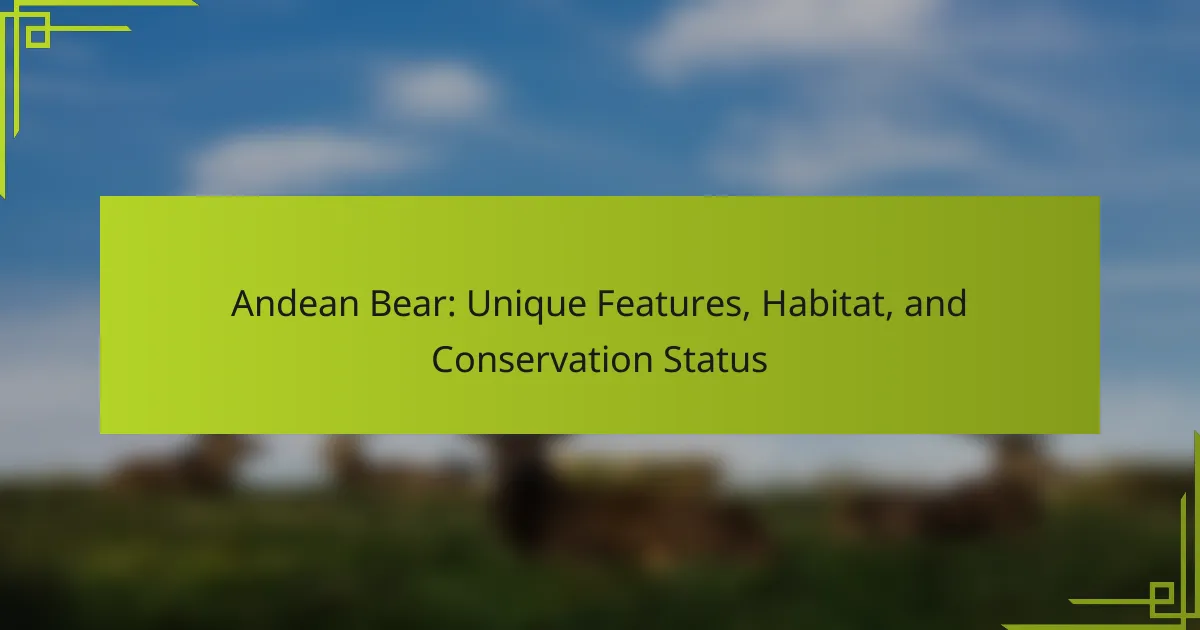The Andean Bear, the only bear species native to South America, is characterized by its unique facial markings and long, shaggy coat, which help it thrive in cold mountainous environments. This species primarily inhabits the Andean mountain range, favoring cloud forests and high-altitude grasslands at elevations between 1,800 and 4,800 meters. The Andean Bear’s diet is mainly herbivorous, consisting of fruits, leaves, and flowers, and it possesses strong climbing abilities. Classified as Vulnerable by the International Union for Conservation of Nature (IUCN), the Andean Bear faces threats from habitat loss, poaching, and human-wildlife conflict, making conservation efforts critical for its survival and population stability.

What are the unique features of the Andean Bear?
The Andean Bear has several unique features that distinguish it from other bear species. It is the only bear species native to South America. The Andean Bear is also known for its distinctive [censured] markings, which resemble a mask. These markings vary among individuals, making each bear unique. Additionally, it has a long, shaggy coat that helps it adapt to cold mountainous environments. The bear’s diet is primarily herbivorous, consisting mainly of fruits, leaves, and flowers. It also has strong climbing abilities, allowing it to navigate trees effectively. The Andean Bear is generally solitary, except during mating season or when a mother is raising her cubs. These features contribute to its adaptation to the diverse habitats in the Andes Mountains.
How does the physical appearance of the Andean Bear differ from other bear species?
The physical appearance of the Andean Bear differs from other bear species primarily due to its distinctive coloration and markings. Andean Bears have a unique coat that is predominantly black with a lighter brown or tan color on their legs and face. They also feature distinctive white or cream markings on their chest, which can vary in shape and size among individuals. This contrasts with other bear species, such as the American Black Bear, which typically lacks these specific markings. Additionally, Andean Bears have a more elongated body and longer limbs compared to many other bears, adapting them for climbing. Their smaller, rounded ears and longer snouts further differentiate them from species like the Grizzly Bear, which has more pronounced features. These physical traits are essential for their survival in the mountainous habitats of the Andes.
What are the distinctive markings and coloration of the Andean Bear?
The Andean Bear has distinctive markings and coloration characterized by a black coat with cream or white markings. These markings typically include a unique “V” shape on the chest. The bear’s face may also feature lighter patches around the eyes and muzzle. The coloration helps the Andean Bear blend into its mountainous habitat. These bears are the only bear species native to South America, specifically the Andes region. Their markings are unique to each individual, aiding in identification. The coloration can vary slightly depending on the bear’s specific location within its range.
How does the size and weight of the Andean Bear compare to other bears?
The Andean Bear typically weighs between 220 to 440 pounds. This weight range is smaller compared to the American Black Bear, which can weigh up to 600 pounds. The Andean Bear also measures about 4 to 6 feet in length. In contrast, the Grizzly Bear can reach lengths of up to 8 feet. The Andean Bear’s size makes it one of the smaller bear species. Its adaptations are suited for its mountainous habitat, unlike larger bear species that thrive in diverse environments.
What behavioral traits are characteristic of the Andean Bear?
The Andean Bear exhibits several characteristic behavioral traits. They are primarily solitary animals, preferring to live alone except during mating season or when a mother is with her cubs. Andean Bears are known for their strong climbing abilities, often ascending trees to forage for food or escape threats. Their diet is diverse, comprising fruits, leaves, and insects, which reflects their adaptability in varying habitats. Communication among Andean Bears occurs through vocalizations, scent marking, and body language. They are generally crepuscular, being most active during dawn and dusk. These traits help them thrive in their mountainous environments.
How does the Andean Bear’s diet reflect its unique adaptations?
The Andean Bear’s diet reflects its unique adaptations by primarily consisting of plant-based foods. This bear is an omnivore, but it mainly consumes fruits, leaves, and flowers. Its adaptations include strong, curved claws for climbing trees to access high fruits. The bear’s long snout helps it forage for insects and other food sources in tree bark. Additionally, its digestive system is adapted to process fibrous plant material efficiently. The Andean Bear’s reliance on seasonal fruit availability showcases its adaptation to the mountainous environment. This diet supports its survival in diverse habitats, from cloud forests to grasslands.
What social behaviors are observed in Andean Bears?
Andean bears exhibit solitary social behaviors. They typically prefer to live alone, except during mating season or when mothers are with their cubs. Social interactions among Andean bears are rare. When they do meet, they may communicate through vocalizations or scent marking. These interactions are usually brief and non-aggressive. Males may establish territories that overlap with females’ ranges. This behavior helps in mating opportunities. Overall, Andean bears maintain a low social structure, primarily driven by individual needs and reproductive cycles.

Where does the Andean Bear inhabit?
The Andean Bear inhabits the Andean mountain range in South America. Its range extends from Venezuela to northern Argentina. The bear prefers cloud forests and high-altitude grasslands. These habitats typically occur at elevations between 1,800 and 4,800 meters. The Andean Bear is also found in areas with dense vegetation and abundant food sources. Its habitat is crucial for its survival, providing shelter and sustenance. The bear’s range is fragmented due to habitat loss and human encroachment. Conservation efforts are essential to protect these habitats and the species.
What are the primary habitats of the Andean Bear in the Andes Mountains?
The primary habitats of the Andean Bear in the Andes Mountains are cloud forests and high-altitude grasslands. These bears prefer areas with dense vegetation that provide cover and food sources. Cloud forests offer a humid environment with a variety of plant species. High-altitude grasslands, known as paramo, provide open spaces for foraging. Andean Bears are also found in montane forests, which are rich in fruit-bearing trees. Their habitat range extends from Venezuela to northern Argentina. These regions are critical for their survival as they support their dietary needs and breeding.
How do altitude and climate affect the distribution of Andean Bears?
Altitude and climate significantly influence the distribution of Andean Bears. These bears thrive in high-altitude regions of the Andes Mountains. They are typically found between 2,500 and 4,800 meters above sea level. The cooler temperatures at higher altitudes are suitable for their thick fur and fat reserves. Climate also affects the availability of food sources. Andean Bears primarily feed on fruits, leaves, and small animals. Changes in climate can alter the vegetation they depend on. Therefore, shifts in temperature and precipitation patterns can impact their habitat range. Studies show that habitat loss due to climate change is a growing threat to their populations.
What types of vegetation are crucial for the Andean Bear’s habitat?
The Andean Bear’s habitat relies on several types of vegetation. Key vegetation includes cloud forests, which provide essential cover and food sources. Bamboo is particularly important as it constitutes a significant part of their diet. Additionally, various fruit-bearing trees and shrubs offer nutrients and sustenance. The presence of these plants supports the bear’s foraging habits and overall survival. Research indicates that habitat loss threatens these vegetation types, impacting the Andean Bear population. Conservation efforts focus on preserving these crucial plant species to maintain a viable habitat for the bears.
How does habitat loss impact the Andean Bear’s survival?
Habitat loss significantly threatens the survival of the Andean Bear. This species relies on mountainous forests and grasslands for food and shelter. Deforestation reduces their natural habitat, leading to decreased food availability. As a result, Andean Bears may struggle to find sufficient nutrition. Fragmented habitats also isolate bear populations, hindering genetic diversity. Reduced genetic diversity can lead to inbreeding, weakening the species. Furthermore, habitat loss increases human-wildlife conflict, as bears venture into agricultural areas in search of food. Studies indicate that habitat loss has contributed to declining Andean Bear populations in various regions.
What are the main threats to the Andean Bear’s natural habitat?
The main threats to the Andean Bear’s natural habitat are deforestation, habitat fragmentation, and climate change. Deforestation occurs due to agricultural expansion and logging activities. This reduces the available forest area for the bears. Habitat fragmentation isolates bear populations, making it difficult for them to find mates and food. Climate change alters the ecosystems where Andean Bears live. It affects the availability of their food sources, such as fruits and plants. These threats significantly impact the survival of the Andean Bear in the wild.

What is the conservation status of the Andean Bear?
The conservation status of the Andean Bear is classified as Vulnerable by the International Union for Conservation of Nature (IUCN). This classification indicates that the species faces a high risk of extinction in the wild. Factors contributing to this status include habitat loss, poaching, and human-wildlife conflict. The Andean Bear’s population is estimated to be decreasing. Conservation efforts are in place to protect their habitat and mitigate threats. These efforts aim to stabilize and increase the bear population over time.
What is the current population trend of the Andean Bear?
The current population trend of the Andean Bear is declining. This species faces habitat loss due to deforestation and agricultural expansion. Additionally, poaching and human-wildlife conflict contribute to its decreasing numbers. Recent estimates suggest that there are fewer than 2,500 mature individuals remaining in the wild. Conservation efforts are underway, but challenges persist. The International Union for Conservation of Nature (IUCN) lists the Andean Bear as vulnerable. Ongoing research and habitat protection are crucial for reversing this trend.
How is the Andean Bear classified on the IUCN Red List?
The Andean Bear is classified as “Vulnerable” on the IUCN Red List. This classification indicates that the species faces a high risk of extinction in the wild. The Andean Bear’s population is declining due to habitat loss, poaching, and human-wildlife conflict. Conservation efforts are crucial to protect this species and its habitat. The IUCN Red List provides updated assessments based on scientific research and population data.
What conservation efforts are in place to protect the Andean Bear?
Conservation efforts to protect the Andean Bear include habitat preservation, anti-poaching initiatives, and community engagement programs. Organizations like the Andean Bear Foundation work to conserve their natural habitats. They create protected areas and promote sustainable land use practices. Anti-poaching efforts are enforced through patrols and legal measures. Education programs raise awareness about the species’ importance. Local communities are involved in conservation strategies. These efforts aim to reduce human-bear conflict and promote coexistence. Overall, these initiatives are crucial for the Andean Bear’s survival.
How can individuals contribute to the conservation of the Andean Bear?
Individuals can contribute to the conservation of the Andean Bear by supporting habitat protection initiatives. They can participate in local conservation programs aimed at preserving the bear’s natural environment. Volunteering for wildlife organizations helps raise awareness about the species. Educating others about the importance of Andean Bears fosters community involvement. Donating to conservation funds provides financial support for research and protection efforts. Reducing personal environmental impact aids in maintaining the bear’s habitat. Advocating for policies that protect wildlife ensures long-term conservation strategies. Engaging in sustainable practices, such as responsible tourism, minimizes disturbance to Andean Bears and their habitats.
What actions can communities take to support Andean Bear conservation?
Communities can support Andean Bear conservation by promoting habitat protection. They can establish protected areas to preserve natural habitats. Education programs can raise awareness about the importance of Andean Bears. Community-led initiatives can reduce human-wildlife conflict. Sustainable tourism can provide economic benefits while supporting conservation efforts. Local involvement in monitoring bear populations can enhance conservation strategies. Collaboration with conservation organizations can lead to effective action plans. Involvement in reforestation projects can restore critical habitats for Andean Bears.
The Andean Bear, the only bear species native to South America, is characterized by its distinctive [censured] markings, long shaggy coat, and strong climbing abilities. This article explores the unique features of the Andean Bear, including its physical appearance, diet, behavior, and habitat preferences within the Andes Mountains. Additionally, it addresses the threats faced by the species, such as habitat loss and poaching, and outlines current conservation efforts aimed at protecting this vulnerable species. The article emphasizes the importance of habitat preservation and community involvement in ensuring the survival of the Andean Bear.
